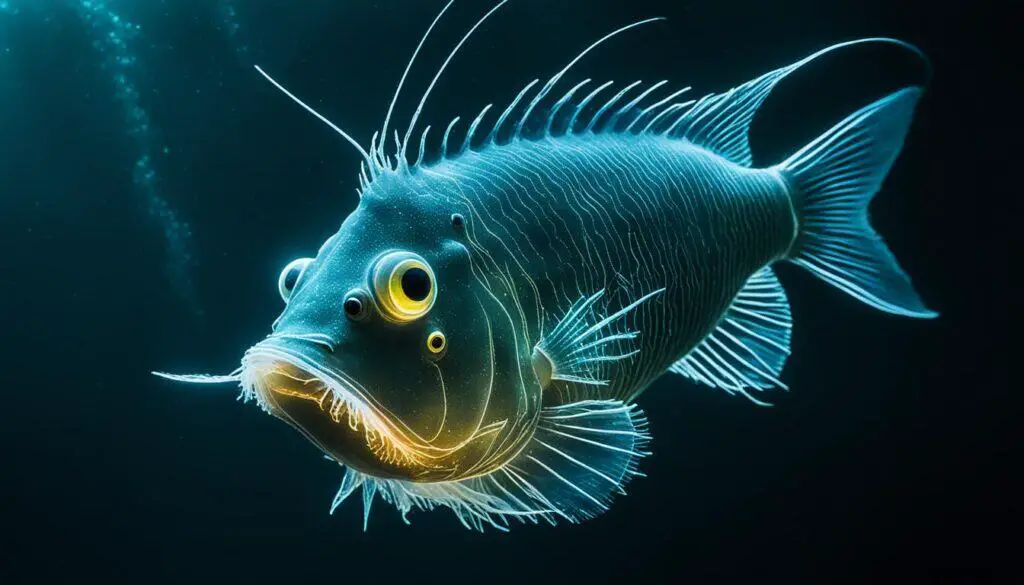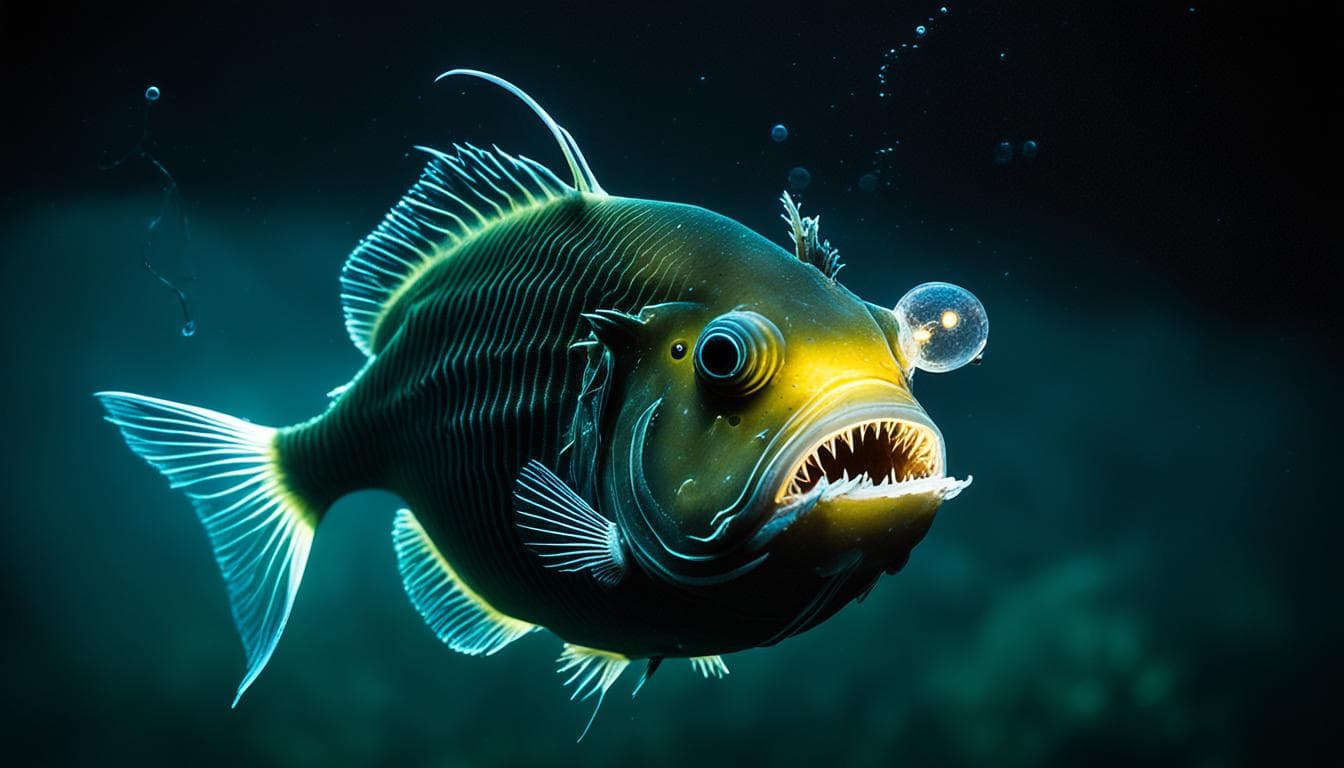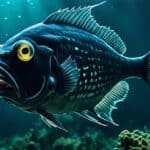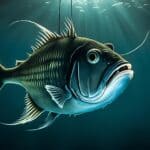The ocean’s depths are full of mysteries, and the anglerfish is one of the most intriguing creatures. You might ask, how do anglerfish use their bioluminescent lure to survive? This special trick is key to their hunting success, drawing in prey with a soft glow from their bodies. By doing this, anglerfish can catch creatures that don’t see the danger coming.
This amazing ability shows how these fish have evolved to live in the dark ocean. It also reveals the complex life of deep-sea creatures.
The Fascinating World of Bioluminescence
Bioluminescence is a fascinating way that some living things make light. This happens when special cells or parts of cells react chemically. In the deep ocean, it’s key for survival and talking to each other among bioluminescent creatures.
What is Bioluminescence?
Bioluminescence means some creatures can make light on their own. This light comes from a chemical reaction with a molecule called luciferin and an enzyme called luciferase. In the sea, many creatures like jellyfish, fish, and plankton can glow. They glow for reasons like catching food, avoiding predators, and finding a mate.
The Role of Bioluminescence in Deep Sea Ecology
Bioluminescence plays a big part in deep sea life. Since sunlight doesn’t reach deep down, bioluminescence is the main light source. This affects many parts of life in the ocean.
Anglerfish use their glow to catch food. Many sea creatures use it to defend themselves by flashing light to scare off predators. Bioluminescence also helps them talk to each other, keeping their social lives going in deep sea communities.
Understanding the Anatomy of the Anglerfish
The anglerfish has special features that help it live in the dark ocean. It has a structure called the esca and a fishing rod-like thing on its head. These help it catch food in the dark.
What is an Esca?
The esca is a glowing lure at the end of the fishing rod on the anglerfish’s head. It’s filled with light-producing bacteria. This light attracts prey and hides the anglerfish from predators in the dark.
The Structure of the Anglerfish’s Fishing Rod
The fishing rod comes from the anglerfish’s forehead. It holds the esca and makes it visible in the dark. The rod is flexible but strong, letting the anglerfish move its lure just right. This helps it catch prey in the deep sea.
How do anglerfish use their bioluminescent lure?
The anglerfish has a special trick for catching prey in the dark deep sea. It uses a bioluminescent lure that helps it survive in a place with little light.
The Mechanism of Light Production in Anglerfish
The anglerfish gets its glow from special bacteria that live in its esca, a light-making part. These bacteria make light by reacting with luciferin and luciferase. When the anglerfish makes the bacteria glow, it looks like real prey to other fish.
How the Lure Attracts Prey
The light from the anglerfish lure tricks small fish and crustaceans into coming closer. It looks like other sea creatures, making them curious. Then, the anglerfish quickly catches its prey. This shows how the anglerfish uses light and speed to catch food in the deep sea.
Symbiotic Relationships: The Role of Bacteria
Anglerfish and their bacterial friends show us the power of symbiotic relationships. These bacteria help make the anglerfish glow in the dark. This glow attracts prey in the deep sea. It’s a key part of how they hunt and shows how complex marine life can be.
Types of Luminescent Bacteria Found in Anglerfish
The Photobacterium bacteria are special in anglerfish. They can make light through chemical reactions. Living in the anglerfish’s esca, they create a bright light to catch prey. Each type of Photobacterium adds different colors and brightness to the light show.
How Anglerfish Obtain Their Bacterial Companions
Anglerfish get their bacteria in amazing ways. They might pick them up from the ocean floor or eat glowing creatures. Once inside the fish, these bacteria live well in special spots. They keep shining to help the fish catch food.

Anglerfish Hunting Techniques
The anglerfish uses a special anglerfish hunting technique to catch its prey. It has unique adaptations and strategies for hunting in the dark deep sea. It stays still and blends in with its surroundings, waiting for prey to come close. Then, it strikes quickly, catching its prey off guard.
Ambush Predator Strategy
This ambush predator strategy makes the anglerfish stand out. It sits on the seafloor and uses a glowing lure to attract fish. This way, it saves energy and waits for the right moment to catch food. In the deep sea, finding food can be hard.
Effectiveness of the Lure in Capturing Prey
The effectiveness of the lure is key to the anglerfish’s success. When it shows its glowing bait, nearby fish come closer, thinking it’s food. Then, the anglerfish opens its mouth and catches the fish. Its sneak attack and shiny lure make it a top predator in the ocean.
| Hunting Strategy | Active Predators |
|---|---|
| Ambush Technique | Chase Technique |
| Energy-efficient | High energy expenditure |
| Camouflage and stillness | Constant movement |
| Attracts prey using bioluminescent lure | Relies on speed and agility |
Species Diversity and Adaptation in Anglerfish
There are about 170 known anglerfish species, showing a wide variety. Each one has unique adaptations, especially in their lures. These lures are key to their survival in the deep sea. They come in different shapes and sizes, helping them hunt better and showing their evolution.
Different Anglerfish Species and Their Unique Lures
Anglerfish have many adaptations for their environments and hunting ways. For example:
- Humpback Anglerfish: This species has a big, bulbous lure that looks like small prey.
- Bearded Sea Devil: Its lure has long, thin parts that move to draw in fish.
- Onefin Anglerfish: This has a long, thin lure that can glow to lure prey.
Ecological Impact of Anglerfish Adaptations
Anglerfish adaptations are key to deep-sea ecosystems. Their lures help them catch prey, making hunting successful. This lets many anglerfish species live in different places and play a big role in the food web. Their adaptations help them survive and keep deep-sea environments healthy.
The Impact of Deep Ocean Changes on Anglerfish
Deep ocean changes are reshaping the homes of anglerfish. Pollution from plastic, chemicals, and heavy metals harms marine life. This affects anglerfish by damaging their habitats and changing where they find food.
Climate change also changes ocean chemistry, impacting food webs. This can hurt anglerfish in ways we don’t see right away. It’s important to understand these effects to help these unique fish.
Effects of Pollution and Climate Change
Pollution and climate change deeply affect anglerfish. For example, damaged coral reefs hurt anglerfish and the whole ecosystem. Changes in food availability make it harder for anglerfish to hunt.
It’s crucial to address these issues to protect anglerfish. This helps keep their food webs healthy.
Conservation Efforts for Anglerfish Populations
Efforts are underway to protect anglerfish from deep ocean changes. Marine protected areas (MPAs) help keep important habitats safe. Community clean-up programs also play a key role in reducing pollution.
By joining these efforts, you help protect anglerfish. This ensures these fascinating fish continue to play a vital role in our oceans.
FAQ
How do anglerfish use their bioluminescent lure?
Anglerfish use their bioluminescent lure to attract prey. They emit light that looks like natural prey. This trick helps them catch fish and crustaceans easily.
What is bioluminescence?
Bioluminescence is when living things make light through chemical reactions. In deep-sea life, it helps with finding mates and spotting prey.
What types of luminescent bacteria do anglerfish have?
Anglerfish have special bacteria that glow, mainly from Photobacterium. These bacteria live in the anglerfish’s esca and help it glow.
How does the anglerfish’s esca function?
The esca is a special part of the anglerfish’s lure. It has glowing bacteria. This lets the fish make a bright light to draw in prey.
What is the ambush predator strategy of anglerfish?
Anglerfish wait quietly and use their glowing lure to lure prey. When prey comes close, they strike fast and catch it off guard.
How do anglerfish obtain their bacterial companions?
Anglerfish get their glowing bacteria from their surroundings. They likely get these bacteria early in life, which helps them hunt better.
What is the ecological impact of anglerfish adaptations?
Anglerfish have special lures and glow to help them live in deep-sea environments. This lets them live in different places and affects the food chain.
How are anglerfish populations affected by climate change?
Climate change and pollution can change where anglerfish live and what they eat. This can upset the balance of their ecosystems, which is a big concern.
What conservation efforts are in place for anglerfish populations?
To protect anglerfish, we’re working on keeping their homes safe and watching out for pollution and climate change. This helps these amazing fish keep playing their important roles in the ocean.







